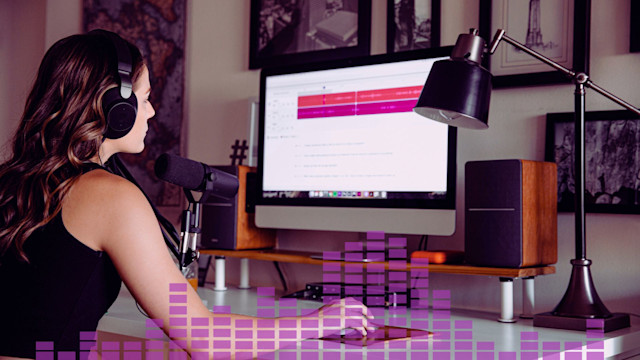Vocal Comping: Pro Tips For Perfect Takes In Your DAW
November 20, 2024 - Master vocal comping to craft flawless vocal performances. Combine the best takes, smooth transitions, and perfect edits for pro-quality tracks in your DAW.

Vocal comping is a game-changing technique for anyone involved in music production, allowing you to craft a single flawless vocal performance from multiple takes.
By carefully selecting the best segments from multiple vocal takes, you maintain the authenticity of a live performance while enhancing its overall quality.
This process has become a staple in the industry, used by both aspiring producers and seasoned professionals to meet the high standards of today's music scene.
I use vocal comping even on sessions with the very best singers. Certain words or phrases in one take might simply convey the emotion and energy better, and vocal comping helps combine those vocal parts into one single perfect performance.
Vocal comping is a key step in professional vocal production. It offers you the chance to highlight a singer's strongest moments. You no longer need to settle for less than perfect; instead, you can create a cohesive and polished final track that captures each session's intended emotion and nuance.
You now have full control over the final product, ensuring each note and phrase aligns exactly as envisioned.
Mastering vocal comping gives you a competitive edge in producing clean, professional vocals.
The Essentials of Vocal Comping
Understanding Vocal Takes

Vocal takes are separate takes in a recording session where the artist was recorded singing or playing the same part multiple times.
This strategy allows you to capture different nuances and emotions, providing a range of options to work from when creating the ideal final vocal track.
Carefully listen to each take to identify the strengths and weaknesses. Pay attention to pitch accuracy, emotional delivery, and lyrical clarity. Understanding these elements is crucial for selecting the best parts for your final track.
Selecting the Best Performance
Choosing the best take involves identifying the most compelling segments from each recording.
Focus on finding parts where the emotion, pitch, and timing are spot-on. You can work at as granular level as you want, anything from selecting complete chorus sections from one take and verses from another to going all the way down to single words or even parts of words.
I find that the best results come from somewhere in between those two extremes. I typically start by picking one main take for each section that sounds great overall, then go deep into detail and pick phrases, words and breaths from each take that give me the best possible final performance.
Once you select the best segments, arrange them to form a cohesive and expressive vocal track. Trust your judgment and create a track that showcases the artist’s strengths and enhances the song's overall quality.
Comping Tools and Digital Audio Workstations
Working in a Digital Audio Workstation (DAW) is key to vocal comping. Most modern DAWs come with essential comping tools that help you combine audio files efficiently and seamlessly. Multi-track editing, crossfading, and automatic alignment are some of the typical tools available in DAWs so you can create a perfect vocal take.
There are many professional-level DAWs out there, and they all have their own approach to vocal comping. Pro Tools, Ableton Live, FL Studio, Cubase and Logic Pro are some of the industry-standard DAWs used by professionals.
Soundtrap is another DAW worth checking out. It's completely online, and you can use it through your browser. Soundtrap features basic audio editing capabilities, including fading audio clips in and out.
Each DAW provides different interfaces and vocal comping techniques. My advice when deciding which DAW to use is to try a few of them out and see which one works best for you. It really comes down to your preferred workflow.
Whichever DAW you choose, familiarize yourself with its specific tools and features. This will help you streamline the comping process and ultimately produce professional-quality results.
Technical Aspects of Comping
Editing and Selection Techniques
Choosing the best parts from multiple takes is a crucial step. This involves listening critically to what each take offers. Pay close attention to individual words and phrases that stand out due to their emotional quality or technical perfection. Use your DAW to switch between takes, focusing on the waveform level effortlessly.
Select portions where breath sounds and pitch remain consistent. It's a good idea to prioritize sections where delivery remains natural and engaging, rather than purely technically perfect segments. The focus should always be on both performance quality and integration with the rest of the track.
When I make these decisions I prefer picking takes with the perfect energy and emotional delivery rather than perfect pitch. Pitch can be fixed using tuning plugins if necessary, but you can't add vibe and energy to a take.
Fine-Tuning with Edit Points
Edit points are where you cut and join different takes. You should choose these points carefully to ensure smooth transitions between clips. Use tools within your DAW for detailed adjustments, focusing particularly on timing and pitch alignment.
It's especially important to make sure that edits aren’t noticeable within the context of complete phrases. Sometimes the smooth transition between a single word or phrase from one clip to another can make or break a comp track.
The goal is for the edits to create a seamless flow that supports the overall vocal performance.
Managing Multiple Takes on Take Lanes
Take lanes allow you to organize and manage multiple vocal takes efficiently. By keeping tracks organized, you avoid confusion and make the editing process more intuitive. Each take lane can hold different versions of the vocal performance, making it easier to compare them side by side.
When selecting from take lanes, listen for consistency in pitch and rhythm across takes.
You should organize your DAW's interface by labeling and color-coding take lanes; it's going to be a huge help once you start vocal comping. This structured approach helps you choose the best segments to assemble a cohesive vocal performance.
If your DAW doesn't support take lanes you can achieve a similar setup by manually creating a new audio track for each take, then use one of the tracks as your main vocal comp track.
Edit and move audio clips from the separate tracks to the main comp track and use fades to piece it all together.
Creating the Composite Track
The objective of vocal comping is to create a composite track from various takes. This approach gives a you cohesive and emotion-rich final vocal performance within the context of the full mix, while maintaining the magic of a single take.
Combining the Best Parts
When combining the best parts of different tracks, focus on identifying standout moments from each take. Listen carefully to each vocal performance and pick sections where the lead vocal shines through with clarity, power, and intonation.
The goal is to create a faultless composite track where each piece ties smoothly into the next.
Achieving Emotional Impact

Achieving emotional impact in your final track requires careful attention to the expressive quality of the vocals. Choose takes where the performer conveys the song’s emotions most effectively. Look for nuances in phrasing, dynamics, and timing that add depth and authenticity.
Balancing technical perfection with emotional delivery is of course also important. As I mentioned before, my personal preference is always to go with a take that might not be technically flawless but resonates emotionally.
Prioritize portions that connect on an emotional level, as this will make sure the listeners will feel the essence of the entire song.
Contextualizing within the Full Mix
Contextualizing your composite track within the full mix is crucial. Pay attention to how the vocals interact with other elements of the music. Ensure that your comped vocals fit well into the established arrangement, complementing rather than competing with instruments.
Once you've finished comping vocals for every section of your song, adjust the mix levels, EQ settings, and spatial effects as needed to make sure the lead vocal remains prominent without overshadowing the rest of the mix. Throughout this process, aim to craft a cohesive sound where the vocals serve the narrative and dynamics of the whole song effectively.
Professional Techniques and Best Practices
The Art of Crafting Background Vocals
Creating background vocals involves blending harmony and rhythm to complement the lead vocal. The same vocal comping approach works for backing vocals too, though your goal here is to match timing and vibe with the lead vocal performance.
Start by recording multiple takes of a harmony. It's a good idea to record doubles for most background vocals, especially for sections like the chorus where you want the vocals to project a bigger, more energetic sound.
Then, record more harmonies in layers that support the lead vocal. The number of takes needed depends on how well the artist is performing and how complex the background vocals are.
Once you're done recording and editing all backing vocal layers, position them at strategic points in the song to enhance the overall texture.
Pay close attention to timing and pitch to ensure harmonies are tight and cohesive.
You can add effects like reverb or delay to background vocals to create depth without overshadowing the lead. This results in a richer, more complex sound that supports a great vocal track.
Utilizing a Rating System for Takes
Developing a rating system for your vocal takes can streamline the comping process. Listen to each take and assign a score based on criteria such as pitch accuracy, emotional impact, and clarity.
You should aim to capture both technical precision and emotional depth in your ratings. Utilize a simple star or numerical rating system to quickly identify the best performances. This practice helps you compile a perfect vocal performance while also making editing faster.
Seamless Transitions and Smooth Edits
Achieving smooth transitions between takes is crucial for a polished final product. Focus on finding natural breaks in the vocal line, such as pauses or consonant sounds, to stitch together different takes.
Use audio editing tools to crossfade between clips, minimizing audible shifts. This part depends heavily on what kind of tools your DAW provides; some have comping tools that automatically add appropriate crossfades.
Fine-tuning gain levels and EQ settings can further blend takes for seamless transitions. Pay careful attention to details and you'll create a fluid, professional recording that sounds like a single, flawless performance.
Finishing Touches and the Final Result
Crafting a polished final vocal track requires attention to detail. It's all about blending technical precision with the irreplaceable human touch. This is how you can achieve both the best sound quality and emotional connection with the listeners.
The Importance of the Human Element

Never overlook the human element. Subtle nuances of performance are what makes a song connect on an emotional level. What I mean by this - while it's important to edit and clean up the final vocal track, it is imperative that you leave some of the human aspects there. No one wants to hear a vocal performance that sounds like a computer sang it!
You should focus on the emotion conveyed through the voice rather than just technical perfection. A good practice is to listen for moments where the vocalist’s personality shines, even if those are not technically perfect. This adds authenticity and warmth to the final result.
From Comp Tracks to Mastered Song
After selecting the perfect vocal takes, it's time to transition from raw tracks to a polished, cohesive final mix. Make sure that each comp track aligns uniformly to create a seamless flow, and correct any timing issues so the vocals fit in and sound completely natural.
Listen through the new track at the end of the session to ensure a balance between technical precision and maintaining the human element. By focusing on both areas, the finished mix will deliver a great performance.
Conclusion
In music production, mastering the art of vocal comping is an essential skill for creating great vocal tracks that resonate with listeners.
The vocal comping process allows you to sift through each vocal recording, selecting the best pieces and combining them into a seamless, perfect take.
By choosing the best bits of each take and focusing on smooth transitions at every edit point, you ensure that good takes are highlighted and bad takes are discarded, giving you a professional, polished end result.
This selection process of analyzing waveform levels and choosing the most natural and emotional takes will bring out the best vocal performances.
Ultimately, investing extra time in perfecting the comping process leads to professional recordings that help feature a perfect vocal sound and capture the true essence of the song.
About the author
Tero Potila is a professional music composer and producer. His career combining knowledge and experience from music, TV, film, ad, and game industries gives him a unique perspective that he shares through posts on teropotila.com.
Get started with Soundtrap today!